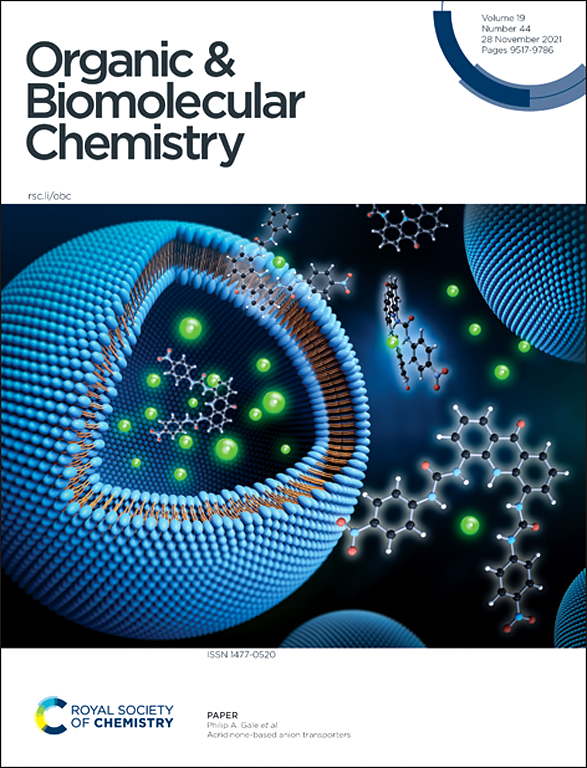无氯微波辅助离子液体催化的芳基磺酸与醇的酯化反应:实验和理论研究。
IF 2.9
3区 化学
Q1 CHEMISTRY, ORGANIC
引用次数: 0
摘要
在杂原子酸的酯化方面,继微波辅助离子液体催化的膦酸酯化之后,在 10%丁基甲基咪唑六氟磷酸盐作为添加剂的情况下,在 200 ℃ 下使用 14 倍过量的醇,也开发了芳基磺酸的酯化。对酯化过程进行了优化,并评估了芳香环中取代基的影响。同时,反驳了 Mandal 等人在甲苯中 120 °C 下 5 分钟仅使用一种等量醇的类似程序。在 B3LYPD3/def2TZVP[PCM(BuOH)]理论水平上,使用显式-隐式溶剂模型以及隐式溶剂模型作为比较,确定了苯磺酸和丁醇反应的机理和能量。探索了三种可能的反应途径:通过 SN2 方案直接酯化苯磺酸,包括丁醇通过具有六价五配位 S 原子的中间体与磺酸的 SO 功能发生亲核加成反应(路线 I)、通过烷磺酸对醇的质子化,然后磺酸阴离子和脱水形成的烷基阳离子重新结合(路线 II);以及 SN1 路线,包括通过质子化磺酸的脱水初步形成锍阳离子,然后对醇进行亲核攻击(路线 III)。从这三种潜在途径的能量来看,烷基化酯化(途径 II)似乎是最主要的途径。微波辐照可能会克服该步骤所需的 132 kJ mol-1 的活化焓。加成-消除(SN2)顺序(路线 I)也可能作为次要反应成分起作用。本文章由计算机程序翻译,如有差异,请以英文原文为准。

A chlorine-free microwave-assisted, ionic liquid-catalyzed esterification of arylsulfonic acids with alcohols: an experimental and theoretical study†
In the area of esterification of heteroatomic acids, after the microwave-assisted ionic liquid-catalyzed esterification of phosphinic acids, the esterification of arylsulfonic acids was also developed applying a 14-fold excess of alcohols at 200 °C in the presence of 10% butyl-methylimidazolium hexafluorophosphate as an additive. The esterifications were optimized, and the effect of the substituents in the aromatic ring was evaluated. At the same time, a similar procedure described by Mandal et al. using only one equivalent of alcohol at 120 °C for 5 min in toluene was refuted. The mechanism and energetics of the reaction of benzenesulfonic acid and butyl alcohol were determined at the B3LYPD3/def2TZVP[PCM(BuOH)] level of theory using the explicit–implicit solvent model, and, as a comparison, the implicit solvent model. Three possible reaction pathways were explored: the direct esterification of benzenesulfonic acid through an SN2 protocol including the nucleophilic addition of butyl alcohol to the SO function of the sulfonic acid via an intermediate with a hexavalent-pentacoordinated S atom (Route I), via protonation of the alcohol by the arenesulfonic acid followed by the recombination of the sulfonate anion and the alkyl cation formed by dehydration (Route II), and an SN1 route involving the initial formation of a sulfonium cation by dehydration of the protonated sulfonic acid followed by the nucleophilic attack of the alcohol (Route III). Judging from the energetics of the three potential pathways, the alkylating esterification (Route II) seems to be the predominant route. Microwave irradiation may overcome the enthalpy of activation of 132 kJ mol−1 required for this protocol. The addition–elimination (SN2) sequence (Route I) may also be operative as a minor reaction component.
求助全文
通过发布文献求助,成功后即可免费获取论文全文。
去求助
来源期刊

Organic & Biomolecular Chemistry
化学-有机化学
CiteScore
5.50
自引率
9.40%
发文量
1056
审稿时长
1.3 months
期刊介绍:
Organic & Biomolecular Chemistry is an international journal using integrated research in chemistry-organic chemistry. Founded in 2003 by the Royal Society of Chemistry, the journal is published in Semimonthly issues and has been indexed by SCIE, a leading international database. The journal focuses on the key research and cutting-edge progress in the field of chemistry-organic chemistry, publishes and reports the research results in this field in a timely manner, and is committed to becoming a window and platform for rapid academic exchanges among peers in this field. The journal's impact factor in 2023 is 2.9, and its CiteScore is 5.5.
 求助内容:
求助内容: 应助结果提醒方式:
应助结果提醒方式:


